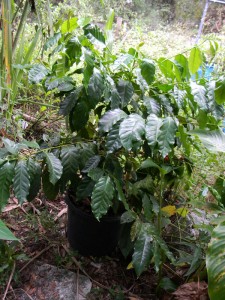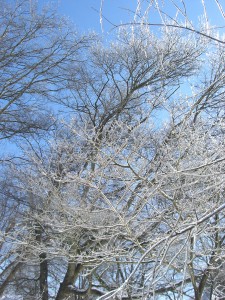By David Goodman
Forbidden fruit has its allure.
As the Scripture says, “Stolen water is sweet, and bread eaten in secret is pleasant.” (Proverbs 9:17)
No matter where we are in life or what we’ve been given… we always seem to want something we don’t have… or can’t have.
The same is true with gardeners – particularly ones who travel.
If you live in North Dakota and take a trip to Miami, you’ll see a wonderful world of plants that you can’t grow.
If you live in Miami, you’ll wish you could grow apples like they have in New York. If you’re in New York and take a trip to Arizona, you might start lusting after a cactus garden and home-grown mesquite wood for your barbecue.
One of the interesting things I’ve noted about gardening: where there’s a will, there’s a way. It’s not always an easy way… or a time-saving way… or even a practical way… but there’s a way.
I have no doubt that there’s someone growing vanilla orchids or mangoes in New York City somewhere. Probably indoors and under lights, but it’s there nonetheless.
As preppers we need to be a bit more practical in the way we approach the plants we wish to cultivate. It’s not about growing something that will impress the neighbors; often, it’s more about growing something the neighbors won’t recognize as food.
When I first started reading about microclimates and zone-pushing, I was fascinated by the idea of growing tropical plants in a non-tropical environment. (And yes, I have my own plan to grow coconuts outside of the tropics… I just need some money, a tractor, some giant pots and some sturdy framing…. ask me later!)
If you live in zone 6, you can only grow so much. If you could add some plants to your homestead that grow well in zones 7-8… wouldn’t that be great?
It’s possible – and the answer may be as simple as a tree.
Trees Are More Powerful Than You Think
If you grow your plants out in the open, freezing nights can be deadly.
I live in an area that’s marginal for citrus. We get nights that reach down into the teens. I know, some of you Northerners laugh at that (I’m looking at you Minnesota) and wish you had it so good, but for citrus the teens can be deadly.
Four years ago I planted two little orange trees; one was in the open, the other one was partly under the canopy of a large oak tree.
We got a frosty night that turned colder than expected. One tree froze to the ground yet the other suffered only minor frostburn.
Guess which tree did what?
You guessed it. The one in the open kicked the bucket.
My friend Craig Hepworth (a bamboo expert as well as being a permaculture guru) once told me that he’d been growing pineapple in his greenhouse for quite a while. He lives at the edges of zone 8 and 9… a place where pineapples are allegedly unable to grow, so he’d assumed they needed the protection on freezing nights.
The problem with his pineapples was that they were a pain to weed. If you’ve ever dealt with pineapple plants before, you know how spiny their sword-like leaves can be. After growing and harvesting them for a time, he decided to clear out a bunch to make room for less painful plants in his greenhouse. Craig told me that he simply ripped out the plants and tossed them around the trunks of some oak trees to deal with later. To his surprise, they grew and continued to bear pineapples despite freezing nights.
After hearing his story, I decided to do the same thing. I’d been growing pineapples in pots for a while and hauling them in and out of my greenhouse. (Getting some in the ground sounded nice. Interestingly, all the literature I’ve read on growing pineapples recommends planting them in full sun, not shade. Through experimentation, I discovered that they’ll fruit even in almost full shade.)
The pineapples have sailed through winter without a hitch and now I’ve also added strawberry guava, naranjilla and edible hibiscus plants beneath my oak trees.
At one point I thought the oaks were just a pain-in-the-neck tree that dropped limbs and took up space where I could be growing edible trees. Now I’m happy I have them.
How Trees Provide Frost Protection
Part of the way trees protect your plants from freezing is through capturing still, warm air on a cold night. Their canopies, even when leafless, hold back the cold of space above. Higher numbers of trees make an even bigger difference, sometimes having double-digit effects on temperature.
Tender plants in the middle of a lawn? Doomed. Tender plants under a bit of forest canopy? Better.
Another way trees protect the plants around them: thermal mass.
How’s that?
Holding back the cold
Well, imagine a tree trunk as a column of water held in place by cellulose fibers. Water takes some serious energy to freeze and even in the winter trees are able to keep their sap from freezing through.
I’ve used barrels of water to keep my greenhouse from freezing; trees can have the same effect on plants near their bases.
Sometimes there are solutions to gardening problems that don’t require serious infrastructure. Knowing what I now know about trees and their ability to provide frost protection, I’m always horrified to see new homesteaders start their properties off by clearing the forest.
Work inside it and clear minimally or you may be giving yourself a harsher climate than you’d like.
Look for a tree, grab yourself a couple of plants from further south, pop them in by the trunk, then see how they travel through the winter. My own results have been impressive.
Though you might not be able to pull off pineapples or citrus, chances are you can pull off something technically “unable” to grow in your area. Not all fruit needs to be forbidden!
David Goodman is a naturalist and hard-core gardener who has grown his own food since 1984. At age five, he sprouted a bean in a Dixie cup of soil and caught the gardening bug. Soon after, his dad built an 8’ by 8’ plot for him and David hasn’t stopped growing since. David writes a regular column for Natural Awakenings magazine in North Central Florida, posts on the Mother Earth News blog, owns a nursery of hard-to-find tropical edibles and grows roughly 1.5 zillion plants on his one-acre homestead. In mid-2012, he launched www.floridasurvivalgardening.com as a place to share his ongoing experiments with tropical and temperate crops. He currently has over 20 intensive beds, multiple field plots, over 100 fruit trees, two food forest projects in different climates and a series of ongoing experiments in-progress – all of which bring him closer each day to complete food security. David is a Christian, an artist, a husband, a father of seven, a cigar-smoker and an unrepentant economics junkie. Visit his daily blog here: Florida Survival Gardening Follow him on Twitter here: http://twitter.com/DavidTheGood


